Passenger car with SSW concept
Kazuya Kashizawa
―― Concept SSW (Super Space Wagon)
FWD two-box cars like the Mirage had increased the degree of freedom in space utilization with the idea of integrating passenger and luggage space. In a social context where lifestyles were diversifying, what users expect next were new ideas to create even larger space with more freedom of use. One answer to this expectation was the Chariot, by adopting a upright driving position like a one-box commercial vehicles and closing the distance between the engine and the driver’s seat, a space with three-row seats could be arranged even in a Mirage-size car. This layout could be described as a 1.5-box, combining an extremely short engine compartment with a large, tall passenger space.
Takaaki Masutani, who had been interested in this type of layout since his student days and had been researching a new genre of automobile, once proposed this idea as a concept model for the 2nd-gen Delica. Unfortunately, it was not adopted for the Delica, but the model, which had something futuristic about it, seemed to had caught the attention of President Kubo, who was briefed on it. I am sure that President Kubo was keeping a close eye on global trends and exploring the possibilities of next-generation passenger cars. Although there was no official development code, Masutani was instructed to continue his research.
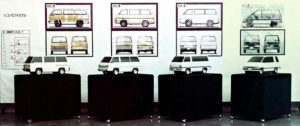
Early concept models of 2nd gen. Delica
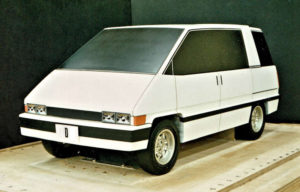
Concept model with semi-cabover layout for 2nd gen Delica proposed by Takaaki Masutani
In the summer of 1977, under the guidance of Shinji Yokoyama and Masao Oshima, Masutani and I were put in charge of the exterior design, and we began the styling study. We created two proposals, one based on the aforementioned concept model and emphasizing an advanced image, and the other more realistic, with an eye toward commercialization. The image-oriented proposal, which connected the top of the hood to the front end of the roof without any breaks, was an excellent idea to create a “single mass,” a tall passenger car with an extremely large passenger space and proportions never seen before. This car was called “SSW (Super Space Wagon)” in the company.
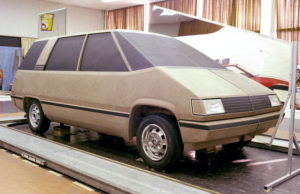
Advanced image proposal (2 proposals in one model using mirrors)
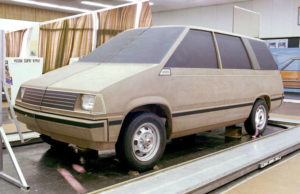
Realistic proposal with commercialization in mind
―― Official project with Mirage platform
Soon this preliminary development was to officially begin, based on the Mirage. My impression when I saw the seating buck for the space study was that although there were three rows of seats, the third row would only accommodate a person with very short legs or a pet dog. Later, when a Chrysler executive who had come to see the seating buck got out of the third-row seat, he caught his pants on the seat slide rail in front and made a gaping hole in it. It was quite cramped for a large American.
Meanwhile, the seating posture of the driver’s seat was distinctive, much different from that of a typical sedan, and felt like sitting in a classroom chair with good posture. Because of the high eye level, the visibility was extremely good. The unique sensation of looking down on an ordinary sedan, as in the famous commercial for a certain family car, was like “the car next to you looks smaller”. Furthermore, it was very easy to get in and out of the car, not like climbing into the driver’s seat like a one-box car, and not like crawling into a sedan. I felt that it was marketable enough as a new type of passenger car.

Initial model based on 1st gen Mirage components
―― Styling concept
When attempting to create an interior space within the limited dimensions, the shape will inevitably become boxy. From a styling standpoint, we would like to narrow the front and rear of the car in planar view, but because of its high overall height, this would not look stable if done too much. We decided to give priority to securing the passenger space, not so much to the narrowing of the front and rear, and asked the interior design team, under the supervision of Mitsuo Kamaike, to incorporate user-friendly ideas.
For the side view, we drew many sketches of a single curve from the top of the nose to the front end of the roof, to create the image of a “single mass” of the concept model. The nose was slanted, and the headlamps were shaped to follow the slope of the grille to create a smooth flow of air. However, since the car has a large frontal projected area, the goal was to create an image of smooth running rather than to enhance aerodynamic performance. The side windows, which tend to be monotonous due to the large glass area, were accented with aluminum C-pillar garnishes.
In the end, the ” single mass” form was not realized due to many disadvantages in terms of cost and practicality, but the unique appearance with its short hood and large passenger space was sufficient to express the new concept.
―― Validation of concept
Various validations were conducted to ensure the success of the new model, an unprecedented concept. With the help of studio engineers, an integrated interior and exterior model was created and consumer surveys were conducted in Japan (September 1978), North America, and Australia (May 1979). At the 23rd Tokyo Motor Show (November 1979), a 7-seat passenger car model and a taxi cab model were displayed to demonstrate the versatility of space utilization, and the response was confirmed.
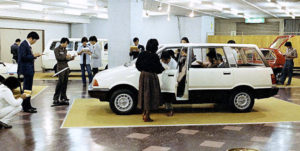
Consumers survey in Japan
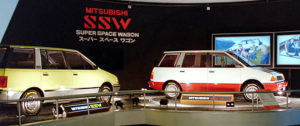
Taxicab (left) and passenger car (right) versions of SSW exhibited at Tokyo Motor Show
While the validation was underway, it was technically decided to use the newly developed Tredia component. After a series of validations, a model was made to reflect the feedback received and to be adapted to the new components, which could be considered as a summary model. At this point, however, the project was put on hold. The results of the validation were not enough to get the go-ahead from the top management.

Tough work of FRP model fablication
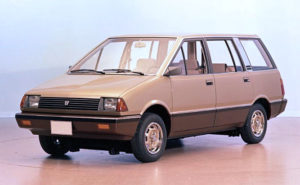
FRP model for North American market when changed to Tredia platform
―― Staying motivated
The project was suspended, but the design development continued with a minimal staff. Masutani and I became continuing members. We persevered and maintained our motivation to make this project a reality. By any means, we ourselves really wanted to have this car.
First, we decided to make a concept panel filled with illustrations to appeal and reaffirm to ourselves what the selling point of this car was and what new sensations it would bring to the market. Initially, at the start of development, a concept panel was made to share the image of the car within the team, but this time we revised the earlier concept panel to make the content more conscious of the mass media at the launching. In addition to physical features such as ease of getting in and out of the car and the space efficiency, the concept panel summarizes the dreams of life that can be realized with this car in a number of scenes. This moment that we spent talking about our dreams was unique in my life with Mitsubishi Motors.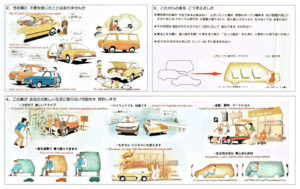
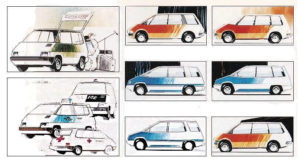
―― Birth of Chariot
In 1981, the project started again, but Masutani and I were no longer the members. The wheelbase was increased by 100 mm during this period, and the interior team had to do a lot of design change, but there was not much change on the exterior. After refining the details, they finally moved on to the production process. One day, six months before the launch of the Chaliot, Nissan launchced the Prairie, a concept similar to the SSW. There is no “if” in history, but if the restart had been a little earlier, the Chariot might have been the first passenger car in Japan to realize the SSW concept.
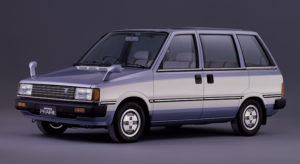
Nissan Prairie Photo Courtesy of Nissan Motor Corp.
The Chaliot(a two-wheeled horse-drawn carriage for combat use in ancient Greece ) was unveiled in February 1983 with this pleasant-sounding naming. At a test-drive event for journalists held at a hotel in Karuizawa, I asked a critic what he thought of the Chariot. He said, ”It’s a very well thought-out car. When cars like this can be sold well, we can say that Japanese motorization has matured.” Looking at the current situation 40 years later, I have a feeling that Japanese motorization has passed through the period of maturity he mentioned and is already heading toward its end. With a touch of sadness, I feel deeply that I was able to design in a good era.
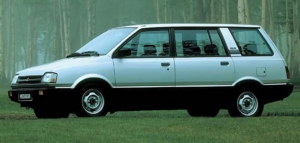
January 2022
Diverse interior utilization from diverse lifestyles
Mitsuo Kamaike
―― Genesis of SSW (Super Space Wagon)
I have loved the outdoors since I was young, immersing myself in sailing when I was a student and often going camping and fly-fishing in the mountains. As such, when I was involved in the design of the Chariot in 1977, I owned a Sigma Super Estate, which I loaded with various goods and traveled around with my family and friends. I was in charge of the interior design of this car, and although it was registered as a commercial vehicle, it had the feel of a passenger car, which was different from a so-called van. At the time, compact cars and sedans were the mainstream, and very few people drove wagons like this, but it was the perfect car for my lifestyle.
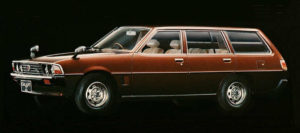
Galant Sigma Super Estate
The origin of the Chariot was a scale model with a semi-cab-over layout proposed by Takaaki Masutani in the early stages of the development of the 2nd gen Delica. Subsequently, the design study was carried out separately from the Delica as a passenger car. With a roomier interior than my Sigma Estate and a wide range of utility features that could accommodate seven people when needed, it was a car that I myself would have loved to have. In fact, my household was of three generations, I thought, “After the Sigma, this would be the next best thing.”
The exterior team began work on a 1/1 clay model, and based on the shape of the model, a seating buck was built to check the interior space, seating posture, and ease of getting in and out. At this time, the car was called SSW (Super Space Wagon).
―― Seating buck and review meeting
The studio engineer was in charge of the basic layout of the seating buck, and Akinobu Kiyofuji, the model planner, worked on the planning and fabrication of the buck. This was an ingenious structure with an adjustable roof height that allowed for study at various heights. After the completion of the seating buck, we had high expectations for the potential of this car, but the results of the evaluation by the relevant departments were not good at all. In particular, the third-row seat, which was problematic in terms of comfort and ease of getting in and out of the car, was severely criticized. If the interior were higher, as in the case of the Delica, it would be easier to get in and out of the car through a relatively small opening, but a slightly higher roof than that of an ordinary passenger car was not enough.

Seating buck at initial development
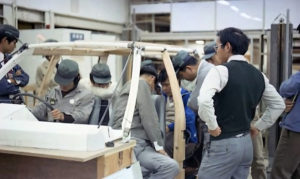
First seating buck heavily criticized
―― Design study in package drawing
The evaluation of the seating back was disappointing, but the problems were found. It was then decided to develop this car as a official project based on the Mirage components. A basic layout was created by the Product Development Department, and based on the new exterior plans, I started planning the interior with my teammate, Ikai, using full-scale package drawings. We put up, full-size paper silhouette of the main functional parts, passengers, and various items that would be loaded for leisure and travel, on the walls, and examined the usability of the car in various situations. In particular, the possibility of seat arrangement was an important point, and this was where the versatility of the car emerges. If we could realize a walk-through to the rear seats, swivel seats, and fully flat seats, as in American full-size vans, we can expect a wide range of uses that have not been possible in passenger cars up to that point.
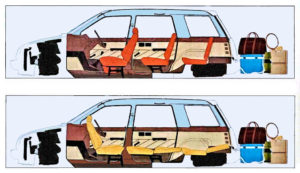
―― Drawing on wall and CAD system
In those days, we spent a great deal of time and effort making drawings on the wall and examining them while moving full-size paper patterns and the like around. This kind of work was quite hard, requiring the body to move up and down, left and right, and sometimes the muscles ached the next day. CAD was starting to be used at this time, and studies began to be conducted on monitors, which were very convenient because they could be freely enlarged, reduced, etc. However, monitor screens at this time were small, and it was still inconvenient to study large objects at actual size. However, technology has advanced remarkably since then, and full-scale studies on a large screen are now commonplace. Nowadays, I fondly remember the work of those days, moving around in front of the wall surface and feeling the size of the car physically.
―― First interior model
Now back to the story. In the first interior model we made, the instrument panel was integrated with the steering column, which was quite a novel design. The goal was to create a design that had never been seen before as a new concept car. The shift lever was on an instrument panel so that a walk-through was possible. The process was repeated several times, with the design evaluated, the engineering reviewed, and the model reworked. About a year later, in September 1978, an FRP model with an integrated interior and exterior was built, and a survey was conducted in Japan with the general public.
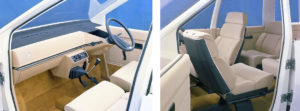
First interior model
―― Planning taxicab version
Based on the results of the survey and the previous studies, SSW was changed to a Tredia base, one class up from Mirage. At the same time, we had begun designing the concept cars for the Tokyo Motor Show. In particular, we planned a taxicab version in addition to the family version we had been planning. This was because, despite being nearly 600 mm shorter than a typical taxicabs of the time, the SSW had a roomy interior, was easy to get in and out of, and had ample luggage space, making it the ideal taxicab for Japan, where the streets were cramped.
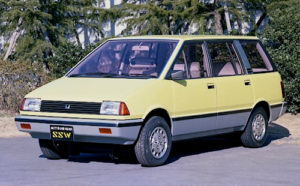
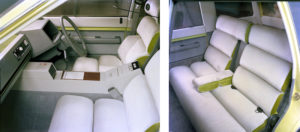
Taxicab version of SSW
At the Tokyo Motor Show in October 1979, SSW was presented as a new concept passenger car. It was the world’s first minivan concept car. (However, the term “minivan” did not exist at that time.) Its unique style, spacious interior, and three-row seats that could be configured in various ways attracted much attention, especially among product planners and designers from other companies, who were taking notes, according to the staff at the show.
―― Ideas from Outdoors
At the end of the summer before the Tokyo Motor Show, I took time out from working on the concept cars to go camping in Owase with eight others, including Kashizawa and Masutani, who were in charge of the exterior design. The purpose was to experience the outdoors using the car, with SSW in mind. We loaded our camping gear, foodstuffs, cooler boxes, and a lot of other stuff into our cars for the trip, one of which was a Delica, which had just been launched. The Delica was indeed a van with a great deal of space, making it the perfect vehicle for such a trip. However, the floor is high enough that getting in and out was not easy, and it was not as agile as a sedan. As expected, the SSW, which combines the best features of a Delica and a sedan, had great potential. We also felt that we needed to find a way to store various things in the car during this trip. We continued to develop ideas for the SSW and subsequent Mitsubishi’s out door oriented vehicles through various leisure activities such as camping, biking, and yachting.
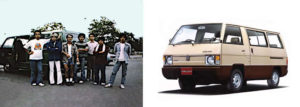
Camping drive with colleagues(left) 2nd gen. Delica (right)
―― Finally realized after suspension
Although SSW attracted much attention at the motor show, the project was subsequently suspended. In the company, where various projects were going on at the same time, a completely new project was not expected by the sales division, and inevitably received less priority. However, the project was resumed around the middle of 1980, and Shigeyuki Owaki joined the team at that time, and serious design work toward mass production finally began.

Interior model with refined design
Various seat arrangements were studied, but a walk-through from the driver’s seat to the rear seats was impossible with the width of this car, considering the shoe size of Westerners, and the instrument panel shifter was abandoned accordingly. The front swivel seats had to be given up as well. Instead, by flippping the seatbacks of the second-row seats, sitting opposite each other with the third row seat was realized. Furthermore, the seats could be made fully flat. In addition, taking advantage of the high front deck, another large-capacity storage box was installed under the passenger glove box, and various other storage spaces were provided to enhance the utility of the car. The instrument panel has a simple yet functional design with a solid instrument cluster on a shelf that creates a sense of spaciousness in the cabin. My favorite part of the design was the grooves on the shelf surface as an accent. The taxicab version we exhibited at the motor show had great potential, but I still think it was a pity that no momentum was generated within the company to pursue this as a project.
In February 1983, six years after the start and after the suspension, Chariot was launched. A short time later, I bought my own Chariot. I often used it for leisure with my family and friends. In 1977, when the development began, the term “New Family” was used to describe the families of the baby-boomers, and that is exactly what my lifestyle was like. I believe that the Chariot was a car born from the new values of the “New Family”.
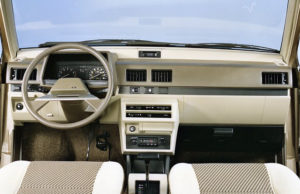
Interior model with almost final design
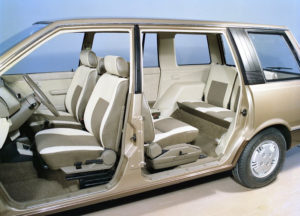 February 2022
February 2022